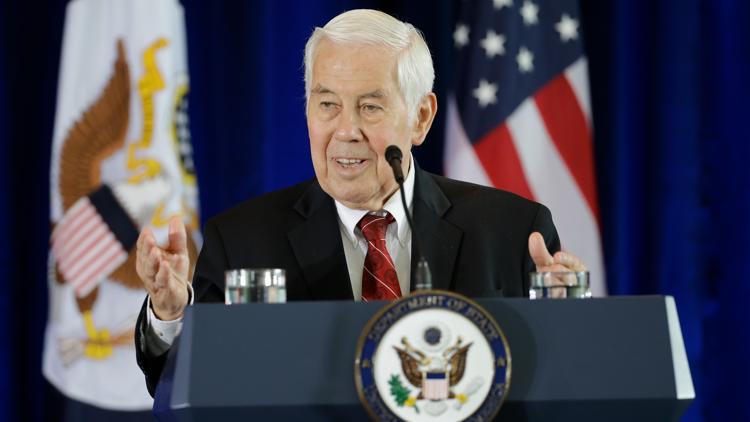INDIANAPOLIS — Covering the 1996 presidential campaign of Indiana U.S. Sen. Richard G. Lugar, I found him in a Drake University classroom a few days before the Iowa caucuses talking with students. As I prepared to enter, a couple of national reporters were exiting, shaking their heads.
"Can you believe that?" one said. "He's talking about Africa."
The unsuccessful Lugar presidential campaign was a cerebral diversion. While some candidates offered up the same scripted talking points over and over again, Sen. Lugar tended to offer remarks aimed at specific audiences. And one of them was what would become the President's Emergency Plan for AIDS Relief (PEPFAR).
PREFAR was supported by Lugar and then-Senate Foreign Relations Chairman Joe Biden (the two rotated in that position) and signed into law by President George W. Bush. Prior to PREFAR, only about 50,000 people in sub-Saharan Africa had been receiving lifesaving anti-retroviral drugs. That quickly grew to 1.4 million. And a generation later, PREFAR has been credited with saving more than 20 million lives in Africa.
Or as Lugar put it, "We should understand that our investments in disease prevention programs have yielded enormous foreign policy benefits during the last five years. PEPFAR has helped to prevent instability and societal collapse in a number of at-risk countries.
"In my judgment," Lugar continued, "the dollars spent on this program can be justified purely on the basis of the humanitarian results that we have achieved. But the value of this investment clearly extends to our national security and to our national reputation."
Next Tuesday, a little more than five years after Lugar passed away at age 87, many of his colleagues and constituents will gather outside Gainbridge Fieldhouse for the unveiling of a monument in his honor. Former Secretary of State Condoleezza Rice will give the keynote, and there will be video commemorations from President Bush and former Georgia Sen. Sam Nunn.
The unveiling of the Richard Lugar Monument will pay homage to one of the most influential politicians in Hoosier history, who received more votes than any other Hoosier. The monument will be installed later in the day in its permanent location at the Lugar Plaza on the south side of the City-County Building where, as mayor, Lugar orchestrated the pivotal era that launched modern Indianapolis.
After winning the mayor’s office in 1967, he ushered in the "Unigov" era which combined many functions of Indianapolis and Marion County. In 1979 he played a major role in saving Chrysler Corporation, which employed 17,170 Hoosiers at the time.
As chairman and then ranking member of the Senate Foreign Relations Committee, his most important legacy came with the Nunn-Lugar Cooperative Threat Reduction Program, which deactivated 7,500 Soviet and Russian strategic nuclear warheads and destroyed more than 1,400 land- and submarine-launched ballistic missiles after the collapse of the Soviet Union.
Nunn and Lugar had discovered Soviet nuclear and chemical weapon depots protected by chain-linked fences and padlocks, housed in chicken coop-style buildings with light streaming through their holey roofs. Shells filled with sarin gas or smuggled highly enriched uranium would have been coveted by terrorists like Osama bin Laden or ISIS. The program paid former Soviet physicists and upgraded security for weapons of mass destruction sites.
The Lugar monument was a five-year project of Jim Morris, Mayor Lugar's chief of staff who would later go on to head the United Nations World Food Programme. That was another frequent topic that Lugar (who also chaired the Senate Agriculture Committee) would broach: hunger and feeding the world.
Upon his death, Gleaners Food Bank of Indiana President John Elliott observed, "Lugar fought creatively for the one in eight Americans who are food insecure. He tirelessly defended the School Lunch Program, including the critical Child Nutrition Reauthorization in 1998, which provides one in five meals to hungry Hoosier families even today.”
Did Jim Morris get to see the Lugar monument before he unexpectedly died last month?
Charlie Richardson, an Indianapolis attorney who helped plan the privately-funded $500,000 monument project, said, "He was on this daily." Richardson, who last talked with Morris the Wednesday before he died, added, "We were all taking instructions from Jim Morris right up until the end.”
I asked Richardson for a "Lugar story."
He responded, "Tell me one."
I told Richardson about accompanying Lugar and Nunn to watch the destruction of a Soviet era SS-25 missile motor north of Moscow in 2007. Lugar had found an aerial photo of Indianapolis tacked to a wall in the crew quarters of a ICBM silo, its intended target. After Lugar, Nunn and then Ambassador Bill Burns (now the CIA director) pushed buttons along with their Russian military counterparts, a rumble could be felt from over a mile away.
When we went to the burn stand to inspect what Nunn likened to “converting swords to ploughshares”, a light rain was falling, and then came a rainbow. "Sen. Lugar, look," I beaconed. Lugar glanced skyward as a serene smile crossed his face though, uncharacteristically, he remained silent.
Richardson had one of his own. "In 2005, when Lugar introduced John Roberts to the Congress," he said of the future Supreme Court chief justice who grew up in Long Beach. "Lugar said, 'Growing up in Indiana one learns early on that talent and accomplishments count, but honesty and integrity count more."
Howey is a senior reporter and columnist for State Affairs/Howey Politics Indiana. Find him on X @hwypol.



